Paste/click the link if you don't receive the images/can't access the videos/links.
http://www.viewzone2.com/electricaluniverse.html
Be Well.
David
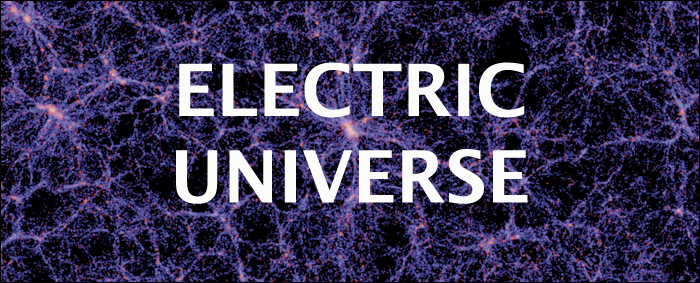
The picture above is our universe. No one could possibly take such a picture because the universe is so big. The Milky Way Galaxy, some 150,000 light years across, is just a tiny dot, barely visible in this computer generated image, based on deep space observations.
What's interesting about the structure of the universe is that it is made up of countless string-like filaments that arrange themselves in parallel lines and sometimes intersect at "nodes" that encircle empty holes. Some scientists have described the universe as looking like Swiss Cheese.
This new view of how the universe is constructed has upset the traditional paradigm of science. It contradicts the model of the universe that was predicted by the 17th century physics, Isaac Newton, in which gravity is the basic fabric of everything. It's also hard to imagine a Big Bang theory with a structure like this. Where's the central point of the initial explosion? Why do we have this strange kind of structure?
At the moment, most scientists are struggling to explain the traditional model in light of this new evidence but others are quite confident that have found an explanation in a theory called "the electrical universe."
It's all about plasma
Science moves slowly and carefully. Old ideas and theories -- paradigms -- are stubbornly defended even when they are opposed by new discoveries. When Sir Isaac Newton developed his gravitational theories in the 17th century, electricity was not yet understood. Now, 400 years later, we have begun to understand the nature of electricity and something interesting called plasma.
Plasma has been called the "fourth state" of matter, after solids, liquids and gases. Most of the matter in the universe is in the form of plasma. A plasma is formed if some of the negatively charged electrons are separated from their host atoms in a gas, leaving the atoms with a positive charge. The negatively charged electrons, and the positively charged atoms (known as positive ions) are then free to move separately under the influence of an applied voltage or magnetic field. Their net movement constitutes an electrical current. So, one of the more important properties of a plasma is that it can conduct electrical current. It does so by forming current filaments that follow magnetic field lines. Filamentary patterns are ubiquitous in the cosmos. That's what you see in the computer generated image.
The Electric Universe model grew out of a broad interdisciplinary approach to science. It is not a technique taught in universities. The Electric Universe is based more on observations and experiment than abstract theory. It recognizes connections between diverse disciplines. It concludes that the crucial requirement for understanding the universe is to take fully into account the basic electrical nature of atoms and their interactions. Strangely, this is not the case in conventional cosmology where weaker magnetism and the infinitely weaker force of gravity rule the cosmos. Such a simplification may suit a theoretical physics based on electrical neutrality of matter in Earthly laboratories but it does not apply in space where plasma dominates.
No where does the Electrical Universe model impose itself more on our paradigm of creation than with regards to the formation of our Sun and planets.
The Newtonian theory of a gravity forming gaseous body has the Sun coalescing and contracting. This is followed by cooler dust clouds which encircle the central mass and form gravitational clumps of accruing planetary bodies. But the electrical model is more dynamic, allowing large clumps of plasma to change orbits and eject smaller globs of plasma that form smaller orbital bodies.
If we consider that the entire universe is made from plasma, then huge galaxies are formed much the same way as suns and planets. This fits neatly in to a kind of "macrocosm" and "microcosm" order.
Propononants of the Electrical Universe observe the various bodies in our solar system. They note the pockmarked surface of the Moon and satellites around other planets but they also pay attention to human history in legends, epics and icons. They envision a time when the planets were in eccentric orbits, often coming very close to Earth and sometimes colliding with each other. They view the craters on the Moon as evidence of a planetary cataclysm which supports their timeline.
This evidence suggests that, at one time, Venus approached the Earth exhibiting a comet-like tail as it streaked across the sky. Electrical arcs zapped between planets as they approached each other, causing deep scars and craters and ejecting debris that rained down on the surface of the Earth. These events, according to theorists, were recorded in human history as epics of the Gods of Heaven and in archetypal shapes and artistic representations of antiquity.
Most of these epics and artistic motifs can be found in ancient Egypt. Here, the electrical universe is revealed by a civilization that appears to have understood what some scientists are just now beginning to realize as a better paradigm for understanding how the universe is made and functions.
Immanuel Velikovsky concluded from his extensive interdisciplinary research that the planet Venus was remembered from the time of the dawn of civilization as a brilliant cometary body.
While there is a wealth of literary sources to draw upon, when it comes to the pictorial evidence it isn't as forthcoming. No images can be conclusively identified as actually representing Venus in cometary form, a situation that essentially shouldn’t exist. After all, it stands to reason that it was naked eye observations that primarily inspired the myths. So, at the very least the imagery should be equal to or analogous to the literary sources -- but this clearly isn't the case.
Have we overlooked something? Is it possible images of Comet Venus have been staring us in the face for decades?
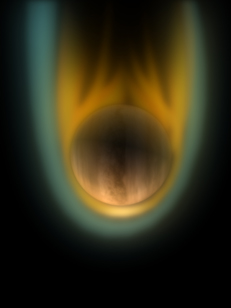
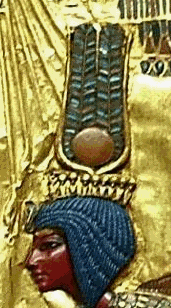
The image on the right has been taken from the back of Tutankhamun’s throne. It depicts the wife of king Tut, Ankhsunamun. The queen is shown wearing a very distinctive crown consisting of a disk surmounted by cow horns and two tall plumes.
This unusual headdress made its appearance in the New Kingdom and features prominently in Egyptian art -- numerous queens can be seen sporting this particular crown. Although the actual shape or outline remained constant (for approximately 900 years), there exist a few variants to the colours shown. For example, the disk was predominantly painted the traditional Egyptian deep red, the ‘horns’ normally black, while the plumes can be gold, a plain yellow, or blue and without the 'filaments'.
Like most Egyptian crowns encompassing a sphere, it somehow represents an aspect of the sun, or so the conventional way of thinking goes. This is a perplexing line of thought since the Sun is a golden glaring ball -- it doesn’t have cow horns wrapped around it and most certainly exhibits no signs of enormous cometary tails.
It is apparent even to the uninitiated that what we are looking at here is a comet -- a large comet with a plumed tail. Furthermore, if Egyptian art is used as a measure of time, this comet graced our skies for nearly a thousand years. It is carved, painted, and represented in statues the length and breadth of the Nile valley. Even the legendary Cleopatra wore this headdress.
Could this particular crown be a true-life physical representation of proto-Venus as it appeared in ancient times?
To quote Wal Thornhill:
'In the electrical model of the solar system, any body on a sufficiently eccentric orbit about the Sun will exhibit cometary features. For ancient people to have seen Venus as an Earth-threatening comet, Venus must have had an eccentric orbit that brought the planet near to Earth'.Are we looking at Velikovsky's comet Venus?
Comparing the comet crown with the Venus diagram on the left reveals some fundamental similarities, far too close to be deemed coincidental. In fact, for all intents and purposes they are virtually identical!
The orb represents the body of Venus: the horns signify the bow shock as the solar wind slams into the Venusian surface, enveloping its body due to a lack of an intrinsic magnetic field. The two large plumes represent Venus' magnetotail—split in two and flowing downstream at least three times its diameter.
The image on the left is just a diagram, and today Venus’ comet tail can only be detected by magnetometers and charged particle detectors. However, place Venus on an eccentric orbit in a highly charged ‘dusty’ environment and the normally invisible magnetotail (and bow shock) would become highly visible.
Wal Thornhill commenting on Venus' cometary magnetotail:
'A power surge in those filaments today would cause them to glow, and Venus would form a "stupendous" cometary apparition in the sky. The forensic evidence would stand up in court, showing that Venus was a comet within human memory'.Science is slowly proving Velikovsky to be correct in a number of areas. Perhaps with the comet crown of ancient Egypt we now have the pictorial evidence to match.
Re (Ra) the Red Sun
A hazed red Sun, planetary chaos, and a solar system besieged by dust and debris.
The Egyptian Sun god Re was typically represented as a sun-disk, or as a falcon-headed man wearing a red sun-disk on his head. Such imagery points to the god’s solar character. The following epithets present traits which are consistent with the life-giving properties of the Sun experienced today.
'Re is the great light who shinest in the heavens
Lord of all lands... praise Re when he riseth at the beginning of each day.
Thou passest over the sky, and every face watcheth thee and thy course,
for thou hast been hidden from their gaze.
Thou dost show thyself at dawn and at eventide day by day'
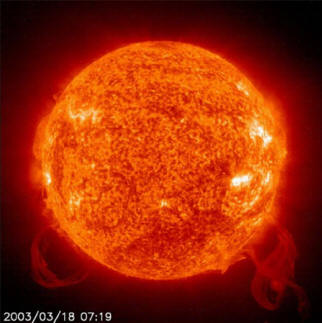
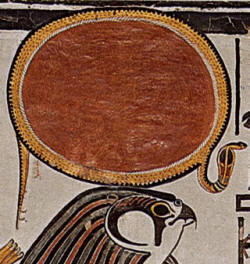
Re's solar disk features heavily in Egyptian art and there exist numerous orbs adorning every monument, tomb, and temple wall throughout Egypt. They are also carved on stela and statues, painted on coffins and sarcophagi, as well as on scrolls of papyrus. They are even incorporated into Egyptian jewellery. Since the Sun was the primary source of life, such ubiquitous representation is only to be expected. However, there is something unusual about the way the Egyptians represented our nearest star that is incredibly revealing when considered alongside planetary chaos. Re's most basic form consisted of a simple red disk. Why was this? Why not portray the Sun as it appeared?
The Sun is a blinding, golden-yellow disk with emanating rays -- a ball of glaring, golden light. A red disk is drab and lifeless by comparison, and yet Egyptian art reveals not one single golden glaring Sun with a complete 360° sweep of sun rays. A perplexing situation, especially when considering that gold was the flesh of the gods and Re was the Sun god par excellence as epitomised in the godly pharaoh's title sa re, which means ‘offspring of Re’.
Whether Velikovsky's Comet Venus was the largest 'volcano' in the solar system, spewing out countless tons of sulphurous gas from its many thousands of volcanic vents, or Mars was disturbed from its orbit to undergo a catastrophic transformation, the result of any cosmic catastrophe would have been the release of immeasurable quantities of debris, dust and gas.
This debris eventually settled down into the plane of the ecliptic where it impacted the planets, the Moon, or fell into the Sun. To understand the effect that a stream of dust and gas 93 million miles long had on the Sun's appearance, we need look no further than the art of the Egyptians. Their portrayals clearly reveal the red haze that surrounded our Sun. The Egyptians carved, drew and painted a red Sun because all they ever experienced was a red Sun. Furthermore, if the duration of Egyptian dynasties is anything to go by, our Sun was hazed red for an incredible 3,000 years.
The supposition that ancient cultures only experienced a diminished red Sun is both profound and exciting. It allows us to take much of the art and many seemingly bizarre beliefs at face value. Not the least being the fact that a hazed Sun means there was no glare, so they were able to look directly at the Sun without being blinded. This led to naked-eye observations of electrical phenomena such as coronal mass ejections (CMEs), flares, and prominences.
The image on the right at the top of the page depicts an Egyptian Sun encircled by a yellow royal uraeus serpent which was known to spit fire and venom at Egypt's enemies. The image on the left was taken by SOHO and can be used for comparison, providing some idea of how the Sun appeared in a world dominated by cosmic catastrophe.
The cobra is a symbolic representation of vicious CME's 'striking out' several times the diameter of the Sun at sungrazing cometary bodies: snakelike CME's protecting the body of Re by spitting fire at Egypt's enemies. In ancient times, those eruptions might have been observable on a daily basis and perceived to be a perennial battle against the forces of evil.
Regarding the association between CME's and comets, Stephen Smith commented in a previous Picture of the Day:
'Comet NEAT swung close by the Sun in 2003, apparently initiating a CME eruption that appeared to impact the comet. Astronomers at the time discounted any relationship between the two events because of the size differential between the comet and the Sun.
'However, several other sungrazers have been associated with violent flares. One event can be a coincidence, two can be long odds, but three or more cannot be dismissed as mere oddities'.
Regarding comet 96P/Machholz:
'It did not rapidly dissipate, however. Instead, its intense charge differential caused a gigantic CME to discharge from the Sun, blasting out for millions of kilometers'. The yellow coronal ring encompassing the snake represents the highly charged million-degree corona of the Sun, bursting through as a yellow ring due to its 20 million degree temperature. Gold really was the 'flesh of the gods', as bursts of golden energy were also observed emanating from the body of Re, as in the image above.
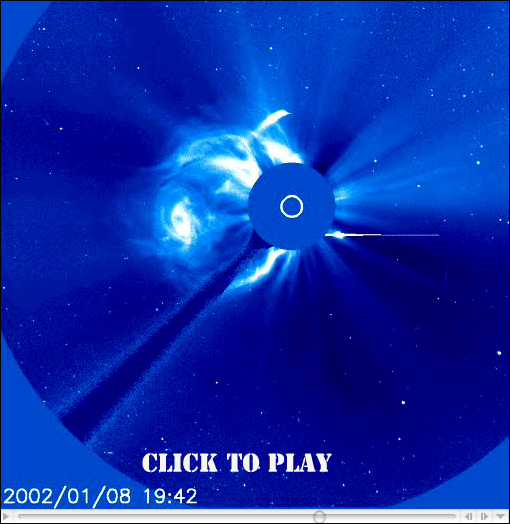
Egypt today has one of the most sunniest and driest climates in the world. Its sunsets and sunrises invoke thoughts of serenity and are a sight to behold. In total contrast, the ancient Egyptians believed Re's daily path across the sky was fraught with dangers.
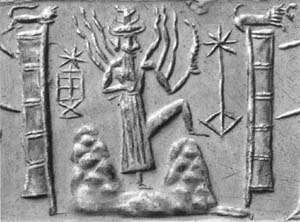 It was believed that the setting Sun prompted a perpetual nightly battle with the demons of the underworld. It was a doomsday scenario, and they believed that the Sun might not shine the next day.
It was believed that the setting Sun prompted a perpetual nightly battle with the demons of the underworld. It was a doomsday scenario, and they believed that the Sun might not shine the next day.
The fighting aspect of the Sun is also played out on Mesopotamian cylinder seals. The 'dispenser of divine justice,' the Sun god Utu/Shamesh [right], is shown with fiery solar 'rays' (CME's) emanating from his shoulders. He also holds a pruning-saw. He is depicted cutting his way through the eastern horizon to again rise victorious. On some seals the snakelike shoulder rays end in stars, indicative of CME's zapping space debris.Upon consideration, a red Sun at war opens a window to many ancient enigmatic beliefs.
The Sahara Desert
An extraterrestrial sand scar?
The light areas in the image above show the wide swath of desert area that extends across Africa, the Middle East, and the entire Asian continent. It encompasses many deserts including the Sahara.
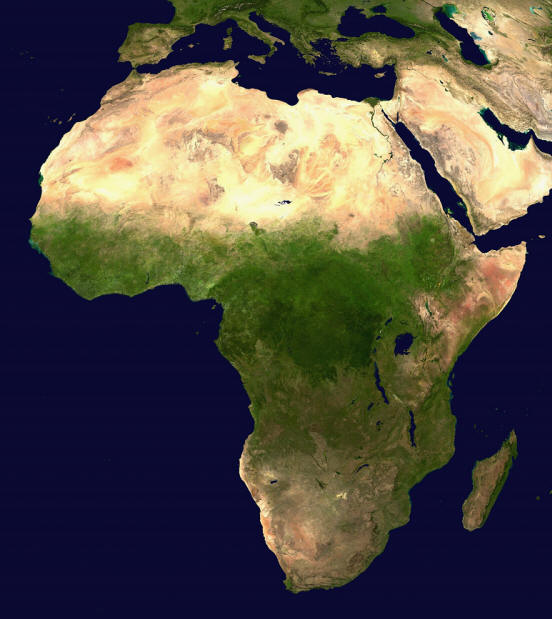
The Sahara is the world's largest hot desert. At over 9,000,000 square kilometres (3,500,000 square miles), it covers most of Northern Africa, making it almost as large as the United States or the continent of Europe. The desert stretches from the Red Sea, including parts of the Mediterranean coasts, to the outskirts of the Atlantic Ocean. Some of the sand dunes can reach 180 meters (600 ft.) in height. Mixed in with the oceanic sands there are large rock formations, boulders, stones and pebbles. Some have compared areas of the Sahara to the surface of Mars.
The sands of the Sahara hold many secrets. It wasn't always a vast desolate ocean of sand; around 5,000 years ago it was a very different terrain. It was a sub-tropical paradise where deer, hippos and elephants were hunted and giraffes and rhinoceros roamed the area. With a plentiful supply of food, thousands of hunter-gatherers flocked to live in this lush savannah.
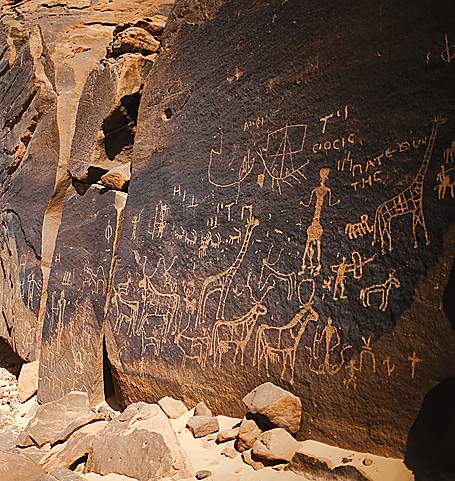
These facts are evident from the discovery of hundreds of human graves and numerous rock paintings [above], depicting people hunting and even swimming. Furthermore, radar images taken by the NASA space shuttle show that beneath the sand are networks of rivers, once spanning the entire Sahara. North Africa was once alive with people! What happened to this lush green world?
It was initially believed the Sahara died out abruptly about 5,000 years ago. However, recent studies have supposedly shown this to be incorrect. Conventional scientists believe the process took about three millennia as reported by Reuters in May 2008.
"The once-green Sahara turned to desert over thousands of years rather than in an abrupt shift as previously believed, according to a study on Thursday that may help understanding of future climate changes. The study of ancient pollen, spores and aquatic organisms in sediments in Lake Yoa in northern Chad showed the region gradually shifted from savannah 6,000 years ago towards the arid conditions that took over about 2,700 years ago. The findings, about one of the biggest environmental shifts of the past 10,000 years, challenge past belief based on evidence in marine sediments that a far quicker change created the world's biggest hot desert."
Sand is the result of finely weathered and eroded rock. It is believed it takes tens of thousands, if not millions of years for exposed rock to weather into sand. The longer this erosion takes place, the finer the grains. The sand in the Sahara is some of the oldest on the planet; it is believed to have existed for seven million years. Some of the sand dunes are rich in iron ore. The impurities stain the quartz particles, which accounts for their yellow colour.
Where did the Sahara sand come from? It did not exist 6,000 years ago. Experts are proposing that vast oceans of sand formed in less than 3,300 years. This is impossible because Saharan sand is some of the oldest on the planet. Putting this into context means that an area the size of the US has been covered in a vast sea of sand in what has to be the blink of an eye in geological terms. This makes no sense because the time frame for the formation of the sand does not allow it according to consensus theories. If the adjoining deserts swathing out across the Middle East and Asia are also considered, this equates to an area twice the size of the US. Where did all this sand come from?
Is it possible the earth is covered with debris from recent cosmic catastrophe? Could debris such as large boulders, rocks, stones, pebbles, dust and sand which are believed to be indigenous to Earth actually be extraterrestrial in origin?
Wall Thornhill speaking on "Coast to Coast" November 26, 2007:
"When you have an highly charged object like a comet coming towards the earth, before it strikes the earth there will be an electrical discharge between the two bodies and that discharge will usually be of sufficient magnitude to destroy the incoming object -- so you end up with a shower of sand and stuff like that."Countless tons of rocks bombarded Earth's atmosphere, fragmenting and breaking up into fine grains of sand. As it fell to Earth it covered vast areas of once-lush, green fertile land, turning it into the barren deserts we see today."The famous Chicago fires where that whole area of the US was lit by strange fires and falls of sand and such like. And this occurred at the time of the disappearance of Biela's comet."
This sand forms a gigantic scar across the landscape which suggests great swarms of debris were hurled at the Earth, and the enormous quantities of sand demonstrates the extent of this bombardment.
Amun - An Ancient Aurora Filled Sky
Planetary chaos and intense geomagnetic storms encapsulated in the 'king of the gods' Amun.
Auroras are striking displays of coloured lights often seen over the Earth’s magnetic poles. They occur when the solar wind particles trapped by the Earth’s magnetic field collide with molecules of air in the upper atmosphere (ionosphere). They are a spectacular sight and take the form of rapidly shifting patches of colour and dancing columns of light of various hues. The colours observed depend on several factors such as atmospheric conditions, intensity of the solar wind, temperature and location. The aurora is always present in almost every area of the sky, but it is usually too faint to be seen except near the North and South Poles.
The intensity of the aurora is dictated by the solar wind, a stream of electrically charged particles from the Sun. When the solar wind blows exceptionally strong, the aurora increases. When the Sun is in the active phase it can unleash powerful magnetic storms that disable satellites, threaten astronaut safety, and even disrupt communication systems on Earth.

Amun is most commonly shown entirely in human form. Often he is standing or sitting on a throne wearing a red, flat-topped crown with two tall plumes and holding a sceptre in his hand. Thousands of images of Amun are to be found throughout the Pharaonic Egypt. The enormous temple complex of Karnak [Above] was the principal home of Amun where he was worshiped as the prominent divine entity. During the New Kingdom, his popularity eclipsed that of other major deities so much so he was referred to as the 'king of the gods'.
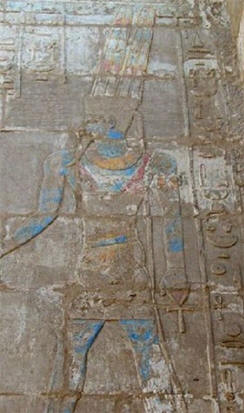
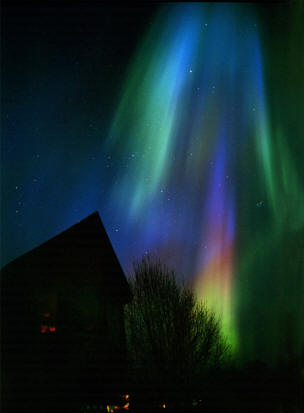
The image on the left depicts Amun in typical form with blue skin, yellow kilt, and red flat-topped crown with tall plumes segmented into sections of blue, red and green (?). A thin yellow frame separates these 'sacred' colours. The Northern Lights photo on the right depicts a plumed or pillared aurora with similar colours i.e. mainly blue supported by green, red and a hint of yellow. Comparing Amun's tall plumes with the aurora photo it is apparent they are clearly a symbolic representation of intense geomagnetic storms that dominated ancient skies.
Amun's epithets are completely consistent with an aurora filled sky.
Mysterious of form
Who raised high the sky
The king of the south and of the north
Prince of rays and beams of light
The flame which sendeth forth rays of light with mighty splendour
Living flame who came forth from Nun
King of heaven, ruler of the two lands
Who makes light/gives free passage
Secret of manifestations and sparkling of shape
Marvellous god rich in forms
Light was his coming into existence on the first occasion
Amun's colours were at times interchangeable. Although his flesh was predominantly blue (main sacred colour), some images reveal a red coloured flesh. His segmented plumes were sometimes coloured yellow or white, as too was his crown. The plumes were often depicted devoid of segments and were painted just one colour, normally yellow or white.
The main colours of the aurora are blue, yellow, red and green and any variants in Amun's colours merely reflect the hues seen at the time which could change on a daily, weekly or monthly basis. Sometimes red neon lights covered the entire sky, other times blue, green, yellow, white or a combination of all colours. The Egyptians reflected what they saw in their art.
The aurora manifests itself in many forms including homogenous arcs, bands, active arcs, rays, pillars, plumes, draperies (or curtains) and coronas. The aurora variations are reflected in the epithet which describes Amun as the 'One creator who has millions of forms & transformations'.
Amun was also known as 'the hidden one' and the ‘one whose true form could never be known’. Such 'hidden' traits reflect the transparency of the aurora. Unlike the light emanating from the body of the Sun, the auroral light had no solid body or attributable physical 'form'. In this respect the Egyptians had a blank canvass, and so chose to encapsulate the aurora as a human being adorning auroral hues and a plumed auroral crown.
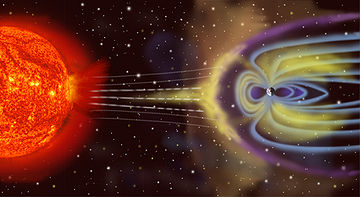 The solar wind is deflected around the earth to form an enormous magnetotail [right] which can extend more than 3,976,766 miles out into space. It is divided into two lobes, or tails, rising and setting in opposition to the Sun. Today it is invisible. From the point of view of Earth's horizons it appeared as two mountains with the title 'Lord of the Two Mountains'. Those electrical apparitions were also attributed to Amun. It's probably why he wore two plumes on top of his crown and not one, or three.
The solar wind is deflected around the earth to form an enormous magnetotail [right] which can extend more than 3,976,766 miles out into space. It is divided into two lobes, or tails, rising and setting in opposition to the Sun. Today it is invisible. From the point of view of Earth's horizons it appeared as two mountains with the title 'Lord of the Two Mountains'. Those electrical apparitions were also attributed to Amun. It's probably why he wore two plumes on top of his crown and not one, or three.
During that period all close proximity planetary bodies exhibited highly visible electrical traits (this would include the cometary plumes of Comet Venus). These were all attributed to Amun. It is the very reason why the omnipresent Amun/aurora rose to prominence to become the 'king of the gods'.
Perhaps 3,000 years of cosmic catastrophe is staring us in the face by way of every façade the length and breadth of the Nile Valley.

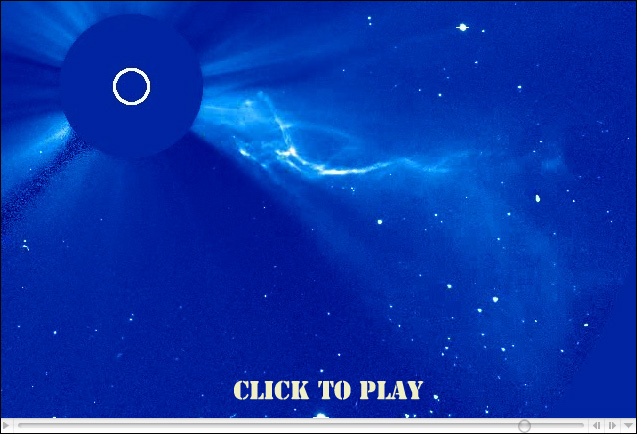




No comments:
Post a Comment